Looking back to the beginning of our homeschool journey, one thing I was totally intimidated by was poetry. As I discovered Charlotte Mason-inspired homeschool accounts on Instagram, I kept seeing children reciting long verses from famous poets, sipping tea at “poetry tea time,” and copying excerpts of poems with deep language as early as first grade. I wasn’t raised in an educational environment like this, so it was all new to me. How could such young children appreciate such rich language and complex meanings? Why even teach poetry?
I began to read Charlotte Mason’s words and this passage hit me like a ton of bricks:
Older children should practice reading aloud every day, and their readings should include a good deal of poetry, to accustom him to the delicate rendering of shades of meaning, and especially to make him aware that words are beautiful in themselves, that they are a source of pleasure, and are worthy of our honour; and that a beautiful word deserves to be beautifully said, with a certain roundness of tone and precision of utterance. Quite young children are open to this sort of teaching, conveyed, not in a lesson, but by a word now and then.
Charlotte Mason, Volume 1
Poetry introduces children to beautiful thoughts and language. It gives depth and meaning to words. Reciting poetry encourages children to speak with excellence and precision. Young children can engage with poetry by simply hearing and enjoying it.
So, when my oldest children were preschool-age, I decided to jump in with a few poetry books and keep it light-hearted. I would bake muffins and brew some tea and read a few poems aloud. Kids would spill tea, ask a thousand questions, or completely zone out. I knew it was worth continuing on though.

In this blog post:
- Including poetry in your Morning Time routine
- How we study poetry in my homeschool
- How we are studying poetry in our homeschool this year
- How to add poetry to your homeschool routine
- Free poetry booklist for kids [Printable PDF download]
Including poetry in your Morning Time routine

As my children have grown, I’ve always included poetry in our daily Morning Time routine. I include it in our Morning Time Menus (simply a menu cover with all of our Morning Time printables in it). Each morning we read the poem aloud and interact with it in a different way. We also copy the poem to practice handwriting and grammar, memorize selections of the piece, and study the poet. Poetry has added such depth and beauty to our home education.
I have included poetry selections in all of the Treehouse Schoolhouse curriculum. Each selection is linked to specific ways to engage and respond to the poems and poets. In A Connected Christmas, you will find poems about the majesty of winter, the emotion of Christ’s arrival, and the wonder of three kings. An Expectant Easter includes selections featuring the beauty of springtime robins, the depth of the crucifixion, and the celebration of the resurrection. Treehouse Nature Study features a nature-themed poem each week with themes like the beauty of colorful autumn leaves, the wonder of the eagle, blooming flowers in spring, rainbows in the sky, and many more. In these guides, you will find poems from great poets like A.A. Milne, Robert Louis Stevenson, and Emily Dickinson.
How we study poetry in my homeschool

Here are some of the ways we work with poetry in our homeschool. This is also how poetry is integrated into lesson plans in Treehouse Schoolhouse curriculum:
- Read, enjoy, and discuss new language and ideas in the poem.
- Imagine a scene that displays the full poem or a part of the poem. Draw or paint a picture of what you imagine.
- Do a poet study. Look up the poet online and read a biography. Find where the poet was born on a world map. Mark the poet’s life on a timeline.
- Copy an excerpt or the full poem. Practice handwriting and grammar as you copy.
- Practice recitation with the poem, focusing on posture, expressive reading, and clarity of speech.
- Memorize the entire poem, or just a portion.
How we are studying poetry in our homeschool this year

This year, we will enjoy poetry as part of our morning family Bible studies. My family is starting our mornings with Rooted Family Bible Curriculum, an 18-week family Bible curriculum that invites family members of different ages to join together for daily declarations, Scripture reading, heartfelt discussion, and prayer prompts, along with opportunities to explore beauty subjects, creative expression, and notebooking. As we study passages of Scripture, we will read poetry that coordinates with the weekly Bible study theme.
In the first week of Rooted, as we enter into discussion on our Christian identity, we read “The Hand Divine” by American poet Daniel C. Colesworthy. As we talk about being made to worship God, we explore this idea through “Beautiful Savior” by theologian and minister Joseph Augustus Seiss. I love how reading poetry gives us beautiful words and ideas to discuss ideas so close to our hearts. It gives us a platform to look at a subject from another point of view, and gives us space to consider a subject more deeply.
How to add poetry to your homeschool routine

I recommend reading one or two poems aloud each day during your lesson time and not pushing any appreciation or interpretation from your children. Simply read poems aloud and see what your children think. You could coordinate poems with your areas of study, or just read selections from books of poetry throughout the week.
Over time, the goal is that children will come to enjoy the unique rhythms of poems, new vocabulary words, rhyming sounds, and clever meanings. Don’t worry if they don’t show interest right away. By continually introducing children to new poems, over time they will likely show a greater interest and understanding along the way.
One simple way to get started with poetry in your homeschool is to add books of poetry to your home library. This post lists my must-have children’s poetry and story treasury books that we own, use, and love. These are the kind of books that you display on your family bookshelf, open again and again, and that could be family heirlooms one day.
More poetry resources from Treehouse Schoolhouse
Enjoy these poetry resources from Treehouse Schoolhouse to add beauty and creativity to your homeschool days.
Nature Poetry Collection

The Nature Poetry Collection is a 40-page set includes 20 beloved children’s poems on nature themes including animals, bees, birds, butterflies, earth, minibeasts, plants, sky, water, and trees.
Treehouse Nature Study

If you are looking for a more well-rounded, deeper approach to poetry with fully planned-out lessons, consider trying Treehouse Nature Study. This curriculum includes a 13-weeks of study for each season, focusing on a new nature theme every week. It includes poetry as well as art study, folk songs, hand rhymes, living book lists, and nature connection activities.
Treehouse Nature Study is a year-long seasonal nature study curriculum designed with family-style learning in mind. It is a gentle guide meant to invite various ages to connect with each other and the world around them through living books, nature notebooking, hands-on projects, and beauty subjects such as poetry, picture study, and folk songs. Available in both Primary and Intermediate Years, Treehouse Nature Study will provide years of rich education for the whole family.
Flourish Family Bible Curriculum

Engage in a journey of the heart guided by Scripture, beauty, art, hands-on connections, and family discussion with Flourish Family Bible Curriculum. Inspire courage, confidence, and Biblical character in your children by activating their giftings and purpose through their faith. It’s about teaching children to bear fruit in the world around them through Biblical virtues, missional purpose and expressing love.
Flourish is an 18-week family Bible curriculum. Each week centers around one declaration statement related to the themes of Mission, Virtue, and Love. Flourish incorporates beauty subjects with Bible study including daily Scripture readings, discussion and prayer prompts, hymns, poetry, and art study.
Free poetry booklist for kids [Printable PDF download]

Help your children fall in love with poetry and beloved stories with this curated booklist of classics and favorites: Children’s Poetry & Story Treasury Books. Download the list by using the box below.
Do you read poetry in your homeschool? Let me know your experience in the comments below.



![Why Kids Should Still Read Fairy Tales Today [Free Booklist]](https://storage.googleapis.com/treehouse-schoolhouse-media-dev/8901dcb1-img_6905.jpg)